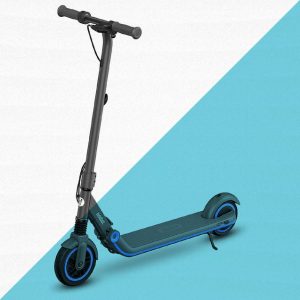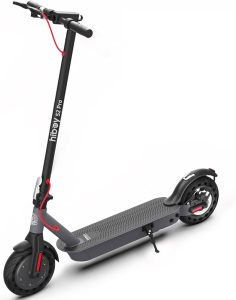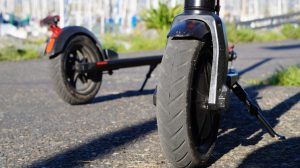Pneumatic tires offer optimal balance in comfort, speed, and safety for electric scooters.
Types of Electric Scooter Tires
Electric scooters have gained significant popularity for their efficiency, convenience, and eco-friendly nature. A crucial component contributing to their performance, safety, and ride quality is the type of tires they use. This section delves into the different types of tires available for electric scooters, each with its unique characteristics, advantages, and disadvantages.
Pneumatic (Air-Filled) Tires
Pneumatic tires, commonly known as air-filled tires, are similar to those used in most traditional motor vehicles. They consist of a rubber outer tire filled with pressurized air.
Advantages:
- Comfort: Pneumatic tires provide better shock absorption, leading to a smoother ride over bumps and uneven terrain.
- Traction: The flexibility of air-filled tires allows for more tire surface to contact the road, offering superior grip and stability, especially at higher speeds.
- Efficiency: They can help in conserving battery life due to reduced rolling resistance.
Disadvantages:
- Puncture Risk: The biggest drawback is their susceptibility to punctures, which can be a significant inconvenience.
- Maintenance: Requires regular pressure checks to ensure optimal performance.
Specifications:
- Life Span: Typically, pneumatic tires last for about 2,000 to 3,000 miles depending on usage and maintenance.
- Cost: The price can range from $15 to $50 per tire, depending on the quality and brand.
Solid (Airless) Tires
Solid tires, as the name suggests, are completely airless and are made from a solid rubber compound.
Advantages:
- No Punctures: Being solid, these tires are immune to punctures, reducing maintenance time and cost.
- Durability: Generally last longer than pneumatic tires, making them a cost-effective option over time.
Disadvantages:
- Comfort: Less shock absorption leading to a harsher ride, particularly on rough surfaces.
- Traction: Can offer less grip compared to pneumatic tires, affecting handling and safety.
Specifications:
- Lifespan: Can last up to 5,000 miles, significantly more than pneumatic tires.
- Cost: Typically ranges between $20 to $70. The initial higher price can be offset by the longer lifespan and lower maintenance costs.
Honeycomb Tires
Honeycomb tires are a newer type of airless tire, featuring a honeycomb structure inside the rubber material.
Advantages:
- Puncture Proof and Low Maintenance: Shares the same benefits as solid tires, eliminating the risk of flats.
- Improved Comfort: The unique honeycomb design provides better shock absorption than traditional solid tires.
Disadvantages:
- Price: Tend to be more expensive than both pneumatic and standard solid tires.
- Weight: Slightly heavier, potentially affecting the scooter’s acceleration and battery efficiency.
Specifications:
- Lifespan: Comparable to solid tires, around 4,000 to 5,000 miles.
- Cost: Generally around $30 to $80 per tire. The higher cost is balanced by the increased comfort and durability.
Factors to Consider When Choosing Tires
Selecting the right tires for an electric scooter is crucial not only for ensuring a smooth ride but also for maintaining safety and efficiency. Riders need to consider several factors including tire size, compatibility, terrain, durability, comfort, performance, and maintenance. Each aspect plays a vital role in determining the overall experience and operational costs.
Tire Size and Compatibility
Before purchasing tires, confirming the size and compatibility with your electric scooter is essential. Using the wrong size can severely affect the scooter’s handling, safety, and efficiency.
Key Points:
- Size: Most electric scooter tires range from 8 to 10 inches in diameter. The width can also vary, affecting grip and stability.
- Compatibility: Always check the manufacturer’s specifications for size and tire pressure requirements. Incorrect tires can lead to reduced performance and increased wear and tear.
Terrain and Riding Conditions
Different terrains demand different types of tires for optimal performance and safety.
Key Points:
- Smooth Surfaces: For city riding on smooth pavements, thinner tires with less tread suffice.
- Rough Terrains: Off-road riding or uneven surfaces require thicker tires with deeper treads for better grip and stability.
Durability and Lifespan
The tire’s durability directly impacts the scooter’s operational cost and the frequency of replacements.
Key Points:
- Material Quality: Higher quality materials typically ensure longer lifespan and better performance.
- Expected Lifespan: Pneumatic tires might need replacement every 2,000-3,000 miles, while solid or honeycomb tires can last up to 5,000 miles.
Comfort and Performance
Comfort and performance are crucial, especially for those who ride frequently or for long distances.
Key Points:
- Shock Absorption: Air-filled tires provide better shock absorption, offering a smoother ride.
- Handling: Tire design and material can significantly affect scooter handling and agility.
Maintenance and Puncture Resistance
Maintenance needs and puncture resistance are practical considerations, especially for regular commuters.
Key Points:
- Puncture Resistance: Solid and honeycomb tires eliminate the worry of punctures, unlike pneumatic tires.
- Maintenance Requirements: Air-filled tires require regular air pressure checks and are more prone to punctures, necessitating more frequent maintenance.
Impact of Tires on Electric Scooter Performance
The tires of an electric scooter significantly influence its overall performance, including speed, acceleration, battery life, handling, stability, and safety. Understanding how different types of tires affect these aspects can help in choosing the right tire for optimal performance and safety.
Speed and Acceleration
Tires play a critical role in determining the scooter’s speed and acceleration capabilities.
Key Points:
- Tire Type and Speed: Smoother tires with less rolling resistance can enhance speed and acceleration, making them ideal for smooth, paved surfaces.
- Weight and Acceleration: Heavier tires, like solid or honeycomb types, can slightly reduce acceleration due to increased weight, impacting the scooter’s agility.
Battery Life and Range
The type and condition of tires directly affect the scooter’s battery efficiency and overall range.
Key Points:
- Rolling Resistance: Tires with lower rolling resistance, like properly inflated pneumatic tires, help in maximizing battery life and extending the range.
- Tire Pressure: Maintaining the correct tire pressure is crucial for efficiency. Under-inflated tires can lead to increased battery drain, reducing the scooter’s range.
Handling and Stability
Tires significantly influence how well a scooter handles, especially when turning or navigating uneven terrain.
Key Points:
- Tread and Stability: Tires with better treads offer improved grip and stability, essential for safe handling.
- Tire Size: Larger tires generally provide better stability and smoother rides over bumps and rough surfaces.
Safety Considerations
The safety of electric scooter riding heavily depends on the quality and type of tires used.
Key Points:
- Grip and Safety: Tires with better grip reduce the risk of accidents, especially on wet or slippery surfaces.
- Puncture Risks: Pneumatic tires, while offering comfort and speed benefits, pose a higher risk of punctures, which can be dangerous during rides. Solid or honeycomb tires eliminate this risk.
Best Tire Brands for Electric Scooters
When it comes to enhancing the performance and safety of electric scooters, choosing the right tire brand is crucial. Some brands stand out for their quality, durability, and performance. This overview highlights top tire brands, providing a comparative analysis and summarizing user reviews and testimonials to assist in making an informed choice.
Brand Overviews
Michelin: Known for high-quality and durable tires, Michelin offers options that enhance grip, longevity, and overall performance. They are a preferred choice for riders prioritizing safety and efficiency.
Bridgestone: With a reputation for reliability and innovation, Bridgestone tires are designed to offer excellent traction and durability, making them ideal for various riding conditions.
Continental: Continental tires are celebrated for their superior construction and ability to provide a smooth ride on different terrains. They strike a fine balance between comfort, durability, and performance.
Comparative Analysis
- Durability: Michelin and Bridgestone often rank high, offering longer lifespans due to their robust construction.
- Performance: For riders looking for speed and agility, Continental tires might be the better choice because of their lighter weight and lower rolling resistance.
- Price: While Michelin and Bridgestone can be on the higher end of the price spectrum, their longevity and reliability often justify the cost. Continental offers competitive pricing, appealing to budget-conscious riders.
User Reviews and Testimonials
Michelin: Users frequently praise Michelin for their puncture-resistant design and long-lasting material, though some note the higher price point as a downside.
Bridgestone: Most reviews highlight the excellent grip and stability provided by Bridgestone tires, ensuring safety in varied riding conditions. However, a few users mention the tires being slightly harder, impacting comfort.
Continental: Riders appreciate Continental’s balance between performance and cost, citing good handling and durability. Some feedback indicates a compromise in shock absorption compared to more premium brands.



